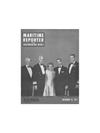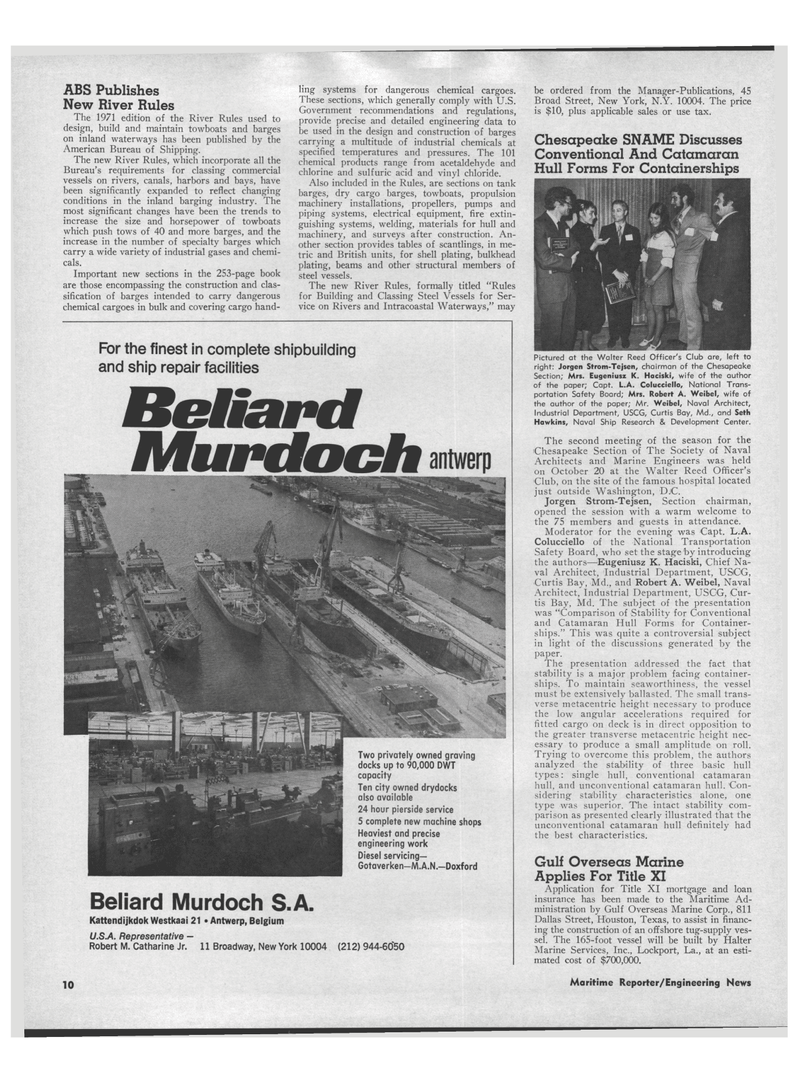
Page 8: of Maritime Reporter Magazine (December 1971)
Read this page in Pdf, Flash or Html5 edition of December 1971 Maritime Reporter Magazine
ABS Publishes
New River Rules
The 1971 edition of the River Rules used to design, build and maintain towboats and barges on inland waterways has been published by the
American Bureau of Shipping.
The new River Rules, which incorporate all the
Bureau's requirements for classing commercial vessels on rivers, canals, harbors and bays, have been significantly expanded to reflect changing conditions in the inland barging industry. The most significant changes have been the trends to increase the size and horsepower of towboats which push tows of 40 and more barges, and the increase in the number of specialty barges which carry a wide variety of industrial gases and chemi- cals.
Important new sections in the 253-page book are those encompassing the construction and clas- sification of barges intended to carry dangerous chemical cargoes in bulk and covering cargo hand- ling systems for dangerous chemical cargoes.
These sections, which generally comply with U.S.
Government recommendations and regulations, provide precise and detailed engineering data to be used in the design and construction of barges carrying a multitude of industrial chemicals at specified temperatures and pressures. The 101 chemical products range from acetaldehyde and chlorine and sulfuric acid and vinyl chloride.
Also included in the Rules, are sections on tank barges, dry cargo barges, towboats, propulsion machinery installations, propellers, pumps and piping systems, electrical equipment, fire extin- guishing systems, welding, materials for hull and machinery, and surveys after construction. An- other section provides tables of scantlings, in me- tric and British units, for shell plating, bulkhead plating, beams and other structural members of steel vessels.
The new River Rules, formally titled "Rules for Building and Classing Steel Vessels for Ser- vice on Rivers and Intracoastal Waterways," may be ordered from the Manager-Publications, 45
Broad Street, New York, N.Y. 10004. The price is $10, plus applicable sales or use tax.
Chesapeake SNAME Discusses
Conventional And Catamaran
Hull Forms For Containerships
Pictured at the Walter Reed Officer's Club are, left to right: Jorgen Strom-Tejsen, chairman of the Chesapeake
Section; Mrs. Eugeniusz K. Haciski, wife of the author of the paper; Capt. L.A. Colucciello, National Trans- portation Safety Board; Mrs. Robert A. Weibel, wife of the author of the paper; Mr. Weibel, Naval Architect,
Industrial Department, USCG, Curtis Bay, Md., and Seth
Hawkins, Naval Ship Research & Development Center.
The second meeting of the season for the
Chesapeake Section of The Society of Naval
Architects and Marine Engineers was held on October 20 at the Walter Reed Officer's
Club, on the site of the famous hospital located just outside Washington, D.C.
Jorgen Strom-Tejsen, Section chairman, opened the session with a warm welcome to the 75 members and guests in attendance.
Moderator for the evening was Capt. L.A.
Colucciello of the National Transportation
Safety Board, who set the stage by introducing the authors—Eugeniusz K. Haciski, Chief Na- val Architect, Industrial Department, USCG,
Curtis Bay, Md., and Robert A. Weibel, Naval
Architect, Industrial Department, USCG, Cur- tis Bay, Md. The subject of the presentation was "Comparison of Stability for Conventional and Catamaran Hull Forms for Container- ships." This was quite a controversial subject in light of the discussions generated by the paper.
The presentation addressed the fact that stability is a major problem facing container- ships. To maintain seaworthiness, the vessel must be extensively ballasted. The small trans- verse metacentric height necessary to produce the low angular accelerations required for fitted cargo on deck is in direct opposition to the greater transverse metacentric height nec- essary to produce a small amplitude on roll.
Trying to overcome this problem, the authors analyzed the stability of three basic hull types: single hull, conventional catamaran hull, and unconventional catamaran hull. Con- sidering stability characteristics alone, one type was superior. The intact stability com- parison as presented clearly illustrated that the unconventional catamaran hull definitely had the best characteristics.
Gulf Overseas Marine
Applies For Title XI
Application for Title XI mortgage and loan insurance has been made to the Maritime Ad- ministration by Gulf Overseas Marine Corp., 811
Dallas Street, Houston, Texas, to assist in financ- ing the construction of an offshore tug-supply ves- sel. The 165-foot vessel will be built by Halter
Marine Services, Inc., Lockport, La., at an esti- mated cost of $700,000.
Maritime Reporter/Engineering News
For the finest in complete shipbuilding and ship repair facilities
BeNard Murdoch antwerp
Two privately owned graving docks up to 90,000 DWT capacity
Ten city owned drydocks also available 24 hour pierside service 5 complete new machine shops
Heaviest and precise engineering work
Diesel servicing—
Gotaverken—M.A.N.—Doxford
Beliard Murdoch S.A.
Kattendijkdok Westkaai 21 • Antwerp, Belgium
U.S.A. Representative —
Robert M. Catharine Jr. 11 Broadway, New York 10004 (212) 944-60"50 10

 7
7

 9
9
